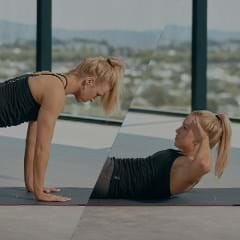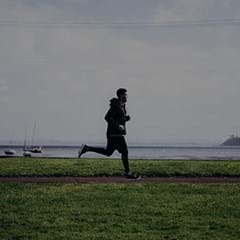What exactly do we know about exercise and our brains?
Every year we learn more about how the body affects the brain. Certainly the brain controls the body, but when we exercise we are using more brain cells than in any other human activity. We now look at the brain as a muscle, one that we can build through movement, which will make our brain cells stronger and more resistant to stresses down the road.
Exercise changes the amount of oxygen the brain gets, the blood flow to the brain, but also the chemistry of our brain. When we exercise we’re changing the levels of endorphins, endocannabinoids, dopamine, serotonin, GABA [gamma-Aminobutyric acid, a neurotransmitter linked to mood and muscle tone] — there’s more of all the good stuff. There’s also more BDNF (brain-derived neurotrophic factor) which I call the brain fertilizer because it’s really important for the brain’s development, for its growth, and as well as protection against stressors such as ageing. The more we have of this stuff the better our brain functions.
AT A GLANCE: EXERCISE AND THE BRAIN
- Exercise improves blood and oxygen flow to the brain, as well as the brain’s chemistry.
- Exercise boosts the brain’s attention, memory and motivation systems.
- It’s only since 1999 that we’ve known humans keep making new brain cells throughout life, and exercise is key to this.
- Exercise influences the brain’s “flight or fight” response; fit people don’t stress out as much as others.
- Exercise is a form of psycho-therapy; it helps people become masters of their own fate.
- Being fit reduces cravings for everything, including the need to check your phone!
- If you exercise you will learn quicker and better.
- Need more proof? Einstein was a keen walker, cyclist and sailor – he was fit!
You talk about three main ways the brain is affected by exercise.
The first way exercise works is that it improves our brain system; our attention system, our memory system, our motivation system – all those systems are boosted when we’re exercising or after we’ve exercised.
There are also the chemical changes in the brain environment I just described that occur in response to exercise. Our brain cells, 100 billion of them, are swimming in a cerebrospinal fluid, which is enriched with all kinds of positive factors that help the brain grow when we’re active. We’ve known since 2000 that to learn anything and to encode new stuff in our brain, our brain cells need to grow, and exercise promotes the best kind of environment for our brain cells to grow in, better than anything else we know of – better than drugs, better than any other human activity.
The third relates to a process called neurogenesis, the making of new brain cells. We only found out we made new brain cells in 1999, but we do, and the biggest promoter of that is exercise. We grow brain cells in different places in the brain, but a major place is one of our key memory areas, the hippocampus.
What’s the connection between exercise and psychological resilience?
Exercise helps with what we call emotional regulation, with mood and anxiety, and it makes our brains more resistant to stressors. Stress comes from the experience of being threatened, so we turn on the sympathetic nervous system, and get ready to fight or flee. If you’re fit it takes a bigger threat from the environment to begin the stress response – people don’t freak out as much or as quickly if they’re in a high degree of fitness.
We now know that some of the new brain cells produced in the hippocampus in response to exercise include the brain’s major inhibitory or ‘brake’ neurotransmitters, such as GABA, which can stop you going into a state of anxiety in response to a stressor. Anxiety is a self-generating kind of phenomenon; you get worried, then you get more worried because you’re worried, and it’s a whole negative spiral; GABA helps put the brakes on.
The traditional model of psychiatric treatment used to be weeks or years on the couch. You’re a psychiatrist, but saying it’s better to get off the couch?
There’s still room for spending time on the couch and seeing your psychiatrist to get things untangled, but if you get moving, you’ll feel better. Many of my patients are much better because they did that.
And a lot of people today want to find alternatives to medicine, so they can put their shoes on and go to the gym as an alternative. Exercise can help people be more masters of their own fate. But you have to show them how it works and why it works – my book Spark: The Revolutionary New Science of Exercise and the Brain provides real stories of people who have conquered various problems through exercise, whether it’s anxiety or depression or a craving for addictive substances.
You recommend exercise as a treatment for a range of addictions, but is that placing one feel-good potentially addictive activity for another?
You could say that, but what you’re doing is changing the brain so that you reduce the cravings that for whatever the addictive substance is, marijuana or cocaine or cigarettes or alcohol, or even the craving to grab your cellphone and see if somebody still loves you. When you are in a higher state of fitness you don’t have as many cravings, and more control over whatever you’re addicted to.
Does it have to be cardiovascular or high intensity exercise?
All types of exercise are useful. We have more evidence of the benefits of aerobic exercise in animal models, although we also have data on people who are into strength training and yoga and dance, all of which have an effect on the brain and on the same areas of the brain. It’s just that aerobic exercise has been studied more, so we have more data. I used to say that it’s hard to get a mice or rat to lift weights, but we now have experimental protocols for rats and mice to climb pulling a weight behind them, and measuring the changes in their brain. Of course it’s hard to get rats and mice to do yoga ...
But every bit helps. Using the standing desk at work is great too. Having quick exercise breaks is great – you can do squats, leg raises, or push-ups by your desk if you’re up to it. Or run up and down the stairs, or walk up and down the stairs and then start running up and down the stairs.
So exercise makes you brainier – but I never thought of Einstein as someone who did a lot of exercise.
That’s not true. He was a bike rider, he walked all the time and he was a passionate sailor. So he was physically active as well as being intellectually active. I have a slide that says Einstein thought of his theory of relativity when he was riding his bike. Although that’s probably not true ...
Going back to all those studies that show you can actually see physical evidence of changes in the brain as a result of cerebral (rather than physical) exercise ...
You can see changes in the brains of musicians and people who have learned another language from an autopsy, or from an MRI or a PET scan, but you see the same growth with people who exercise versus people who don’t. If you learn anything your brain changes. The point is that if you exercise, you’ll learn quicker and better.

Best selling author, John J. Ratey, MD, is an Associate Clinical Professor of Psychiatry at Harvard Medical School and an internationally recognized expert in neuropsychiatry. He has published 11 books including Spark: The Revolutionary New Science of Exercise and the Brain. His latest book, Go Wild explores how we can achieve optimal physical and mental health by getting in touch with our caveman roots, and “re-wild” our lives.







